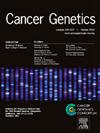GPX4 in triple-negative breast cancer: A key regulator of ferroptosis and therapeutic target
IF 2.1
4区 医学
Q4 GENETICS & HEREDITY
引用次数: 0
Abstract
Breast cancer is the most prevalent cancer among women globally. Triple-negative breast cancer (TNBC) is an exceptionally aggressive and challenging kind of breast cancer to manage. Triple-negative breast cancer (TNBC) lacks oestrogen receptors (ER), progesterone receptors (PR), and human epidermal growth factor receptor 2 (HER2). As a result, there are no effective targeted therapies for it, and it doesn't respond well to standard treatment. Platinum-based treatments and neoadjuvant chemotherapy have shown promise, but the outlook is still not good. Ferroptosis, a type of regulated cell death that depends on iron, is a new way to treat diseases. Ferroptosis inducers like erastin may help make TNBC cells more sensitive to treatment, but they are still hard to deliver because they are toxic and don't dissolve well. Nanotechnology and drug delivery systems, especially exosome-based carriers, are promising ways to get around these problems. Exosomes are a new way to deliver drugs that cause ferroptosis because they are biocompatible and can target specific cells. This is a very interesting area for developing new treatments for TNBC.

GPX4在三阴性乳腺癌中的作用:铁下垂的关键调节因子和治疗靶点
乳腺癌是全球女性中最常见的癌症。三阴性乳腺癌(TNBC)是一种极具侵袭性和挑战性的乳腺癌。三阴性乳腺癌(TNBC)缺乏雌激素受体(ER)、孕激素受体(PR)和人表皮生长因子受体2 (HER2)。因此,目前还没有有效的靶向治疗方法,而且标准治疗效果也不好。以铂为基础的治疗和新辅助化疗已显示出希望,但前景仍不乐观。铁下垂是一种依赖铁的调节细胞死亡,是一种治疗疾病的新方法。像擦除素这样的铁下垂诱导剂可能有助于使TNBC细胞对治疗更敏感,但由于它们有毒且不能很好地溶解,它们仍然难以输送。纳米技术和药物输送系统,特别是基于外泌体的载体,是解决这些问题的有希望的方法。外泌体是一种新的途径,因为它们具有生物相容性,可以靶向特定的细胞。这是开发TNBC新疗法的一个非常有趣的领域。
本文章由计算机程序翻译,如有差异,请以英文原文为准。
求助全文
约1分钟内获得全文
求助全文
来源期刊

Cancer Genetics
ONCOLOGY-GENETICS & HEREDITY
CiteScore
3.20
自引率
5.30%
发文量
167
审稿时长
27 days
期刊介绍:
The aim of Cancer Genetics is to publish high quality scientific papers on the cellular, genetic and molecular aspects of cancer, including cancer predisposition and clinical diagnostic applications. Specific areas of interest include descriptions of new chromosomal, molecular or epigenetic alterations in benign and malignant diseases; novel laboratory approaches for identification and characterization of chromosomal rearrangements or genomic alterations in cancer cells; correlation of genetic changes with pathology and clinical presentation; and the molecular genetics of cancer predisposition. To reach a basic science and clinical multidisciplinary audience, we welcome original full-length articles, reviews, meeting summaries, brief reports, and letters to the editor.
 求助内容:
求助内容: 应助结果提醒方式:
应助结果提醒方式:


